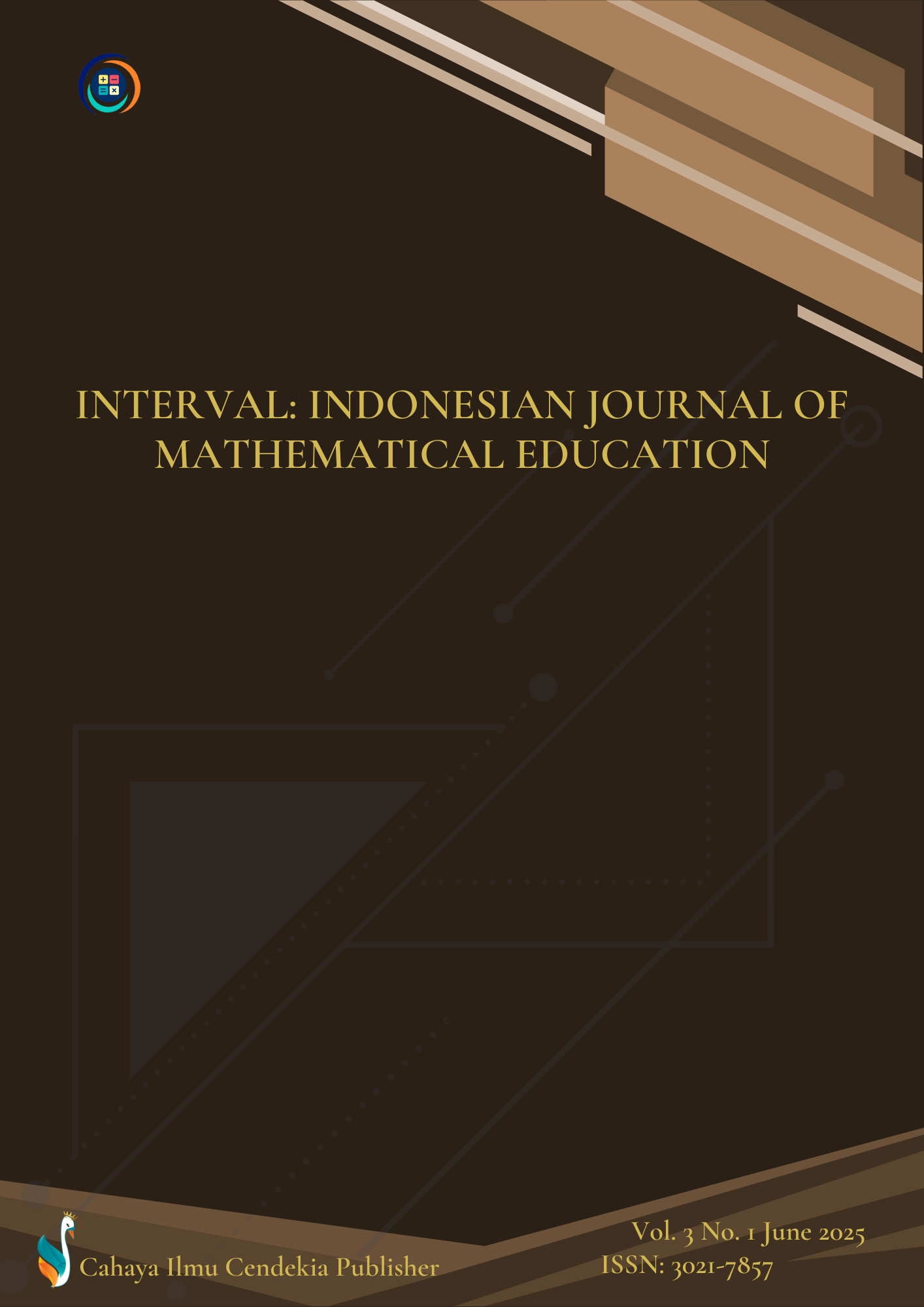Modification of the Fourth Order Runge Kutta Method Based on the Contra Harmonic Average
Abstract
Purpose of the Study
This study aims to modify the fourth-order Runge-Kutta method based on the contra harmonic mean. The research discusses the theoretical modification of the fourth-order Runge-Kutta method.
Methodology
The research was conducted using a literature study method. The study begins by introducing the general form of the Runge-Kutta method up to the nth order. This general form is then specialized to the fourth order. Additionally, the concept of the contra harmonic mean is introduced. After obtaining the general form of the fourth-order Runge-Kutta method and the contra harmonic mean, these two general forms are modified to derive a new formula.
Main Findings
Based on the results, the modified fourth-order Runge-Kutta method has the following equation form:
yi+1 = yi + (h/4) * [(k1^2 + k2^2) / (k1 + k2) + 2 * (k2^2 + k3^2) / (k2 + k3) + (k3^2 + k4^2) / (k3 + k4)],
with an error of order O(h^5). Numerical simulations demonstrate that the modified method provides better results compared to the original fourth-order Runge-Kutta method.
Novelty/Originality of this Study
The numerical simulations using the RKKCM method show improved accuracy compared to the unmodified fourth-order Runge-Kutta method, highlighting the innovation and contribution of this study.
References
K. Velten, D. M. Schmidt, and K. Kahlen, Mathematical Modeling and Simulation: Introduction for Scientists and Engineers. Hoboken, NJ: John Wiley & Sons, 2024.
E. Lozada, C. Guerrero-Ortiz, A. Coronel, and R. Medina, “Classroom methodologies for teaching and learning ordinary differential equations: A systemic literature review and bibliometric analysis,” Mathematics, vol. 9, no. 7, p. 745, 2021, doi: 10.3390/math9070745.
S. Elango, L. Govindarao, J. Mohapatra, R. Vadivel, and N. T. Hu, “Numerical analysis for second order differential equation of reaction-diffusion problems in viscoelasticity,” Alexandria Engineering Journal, vol. 92, pp. 92–101, 2024, doi: 10.1016/j.aej.2024.02.046.
A. A. Khan, M. Ahsan, I. Ahmad, and M. Alwuthaynani, “Enhanced resolution in solving first-order nonlinear differential equations with integral condition: a high-order wavelet approach,” The European Physical Journal Special Topics, pp. 1–14, 2024, doi: 10.1140/epjs/s11734-024-01254-8.
R. Sharma and O. P. Yadav, “The Evolution of Finite Element Approaches in Reaction-Diffusion Modeling,” Archives of Computational Methods in Engineering, pp. 1–22, 2025, doi: 10.1007/s11831-025-10222-x.
M. Genčev and D. Šalounová, “First-and second-order linear difference equations with constant coefficients: suggestions for making the theory more accessible,” International Journal of Mathematical Education in Science and Technology, vol. 54, no. 7, pp. 1349–1372, 2023, doi: 10.1080/0020739X.2022.2140081.
G. Policastro, V. Luongo, L. Frunzo, and M. Fabbricino, “A comprehensive review of mathematical models of photo fermentation,” Critical Reviews in Biotechnology, vol. 41, no. 4, pp. 628–648, 2021, doi: 10.1080/07388551.2021.1873241.
G. Shi et al., “A new passive non-ideal floating memristor emulator circuit,” AEU - International Journal of Electronics and Communications, vol. 170, p. 154823, 2023, doi: 10.1016/j.aeue.2023.154823.
H. Wang, M. Zhu, R. Fan, and Y. Li, “Parametric model‐based deinterleaving of radar signals with non‐ideal observations via maximum likelihood solution,” IET Radar, Sonar & Navigation, vol. 16, no. 8, pp. 1253–1268, 2022, doi: 10.1049/rsn2.12258.
S. Banerjee, Mathematical Modeling: Models, Analysis and Applications. Boca Raton, FL: Chapman and Hall/CRC, 2021, doi: 10.1201/9781351022941.
C. Fu, J. J. Sinou, W. Zhu, K. Lu, and Y. Yang, “A state-of-the-art review on uncertainty analysis of rotor systems,” Mechanical Systems and Signal Processing, vol. 183, p. 109619, 2023, doi: 10.1016/j.ymssp.2022.109619.
G. Noorsumar, S. Rogovchenko, K. G. Robbersmyr, and D. Vysochinskiy, “Mathematical models for assessment of vehicle crashworthiness: a review,” International Journal of Crashworthiness, vol. 27, no. 5, pp. 1545–1559, 2022, doi: 10.1080/13588265.2021.1929760.
X. Qin, Z. Jiang, J. Yu, L. Huang, and C. Yan, “Strong stability-preserving three-derivative Runge–Kutta methods,” Computational and Applied Mathematics, vol. 42, no. 4, p. 171, 2023, doi: 10.1007/s40314-023-02285-y.
M. Saqib, M. Akram, S. Bashir, and T. Allahviranloo, “A Runge–Kutta numerical method to approximate the solution of bipolar fuzzy initial value problems,” Computational and Applied Mathematics, vol. 40, no. 4, p. 151, 2021, doi: 10.1007/s40314-021-01535-1.
F. Yılmaz, H. Öz Bakan, and G. W. Weber, “Weak second-order conditions of Runge–Kutta method for stochastic optimal control problems,” Journal of Optimization Theory and Applications, vol. 202, no. 1, pp. 497–517, 2024, doi: 10.1007/s10957-023-02324-y.
B. B. Sanugi and D. J. Evans, "A new fourth order Runge-Kutta formula based on the harmonic mean," International Journal of Computer Mathematics, vol. 50, no. 1–2, pp. 113–118, 1994, doi: 10.1080/00207169408804246
D. J. Evans, "A new 4th order Runge-Kutta method for initial value problems with error control," International Journal of Computer Mathematics, vol. 39, no. 3–4, pp. 217–227, 1991, doi: 10.1080/00207169108803994.
O. Y. Ababneh and R. Rozita, "New third order Runge-Kutta based on contraharmonic mean for stiff problems," Applied Mathematical Sciences, vol. 3, no. 8, pp. 365–376, 2009.
G. Arora, V. Joshi, and I. S. Garki, "Developments in Runge–Kutta method to solve ordinary differential equations," in Recent Advances in Mathematics for Engineering, CRC Press, 2020, pp. 193–202.
Y. Workineh, H. Mekonnen, and B. Belew, "Numerical methods for solving second-order initial value problems of ordinary differential equations with Euler and Runge-Kutta fourth-order methods," Frontiers in Applied Mathematics and Statistics, vol. 10, 2024, doi: 10.3389/fams.2024.1360628.
Z. Kalogiratou, T. Monovasilis, G. Psihoyios, and T. E. Simos, "Runge–Kutta type methods with special properties for the numerical integration of ordinary differential equations," Physics Reports, vol. 536, no. 3, pp. 75–146, 2014, doi: 10.1016/j.physrep.2013.11.003.
I. Godswill and G. Isobeye, "Comparative convergence analysis of Runge-Kutta fourth order and Runge-Kutta-Fehlberg methods implementation in Matlab and Python applied to a series RLC circuit," International Journal of Innovative Science and Research Technology, vol. 10, no. 3, pp. 2957–2975, 2025, doi: 10.38124/ijisrt/25mar599.
T. Lai, T. H. Yi, H. N. Li, and X. Fu, "An explicit fourth-order Runge–Kutta method for dynamic force identification," International Journal of Structural Stability and Dynamics, vol. 17, no. 10, p. 1750120, 2017, doi: 10.1142/S0219455417501206.
W. Zhai, D. Tao, and Y. Bao, "Parameter estimation and modeling of nonlinear dynamical systems based on Runge–Kutta physics-informed neural network," Nonlinear Dynamics, vol. 111, no. 22, pp. 21117–21130, 2023, doi: 10.1007/s11071-023-08933-6.
R. C. Rockne et al., "The 2019 mathematical oncology roadmap," Physical Biology, vol. 16, no. 4, p. 041005, 2019, doi: 10.1088/1478-3975/ab1a09.
Y. Liu, R. Wu, and A. Yang, "Research on medical problems based on mathematical models," Mathematics, vol. 11, no. 13, p. 2842, 2023, doi: 10.3390/math11132842.
P. Luo et al., "Urban flood numerical simulation: Research, methods and future perspectives," Environmental Modelling & Software, vol. 156, p. 105478, 2022, doi: 10.1016/j.envsoft.2022.105478.
E. Elpianora, M. Berou, X. Kong, K. Hun, and E. Azadegan, “Fourth order Runge-Kutta and gill methods in numerical analysis of Predator-Prey models,” Interval: Indonesian Journal of Mathematical Education, vol. 2, no. 2, pp. 164–177, 2024, doi: 10.37251/ijome.v2i2.1366.
H. Ranocha, L. Dalcin, M. Parsani, and D. I. Ketcheson, “Optimized Runge-Kutta methods with automatic step size control for compressible computational fluid dynamics,” Communications on Applied Mathematics and Computation, vol. 4, no. 4, pp. 1191–1228, 2022, doi: 10.1007/s42967-021-00159-w.
M. Zhang, H. Chen, A. A. Heidari, Z. Cai, N. O. Aljehane, and R. F. Mansour, “OCRUN: An oppositional Runge Kutta optimizer with cuckoo search for global optimization and feature selection,” Applied Soft Computing, vol. 146, p. 110664, 2023, doi: 10.1016/j.asoc.2023.110664.
V. Chauhan and P. K. Srivastava, “Tetra geometric mean Runge-Kutta analysis of bioeconomic fisheries model,” Bulletin of the Transilvania University of Brasov. Series III: Mathematics and Computer Science, pp. 169–180, 2023, doi: 10.31926/but.mif.2023.3.65.2.15.
A. Soomro, S. Qureshi, and A. A. Shaikh, “A new nonlinear hybrid technique with fixed and adaptive step-size approaches,” Sigma Journal of Engineering and Natural Sciences, vol. 40, no. 1, pp. 162–178, 2022, doi: 10.14744/sigma.2022.00013.
N. S. Zulkifli et al., “Centroidal-polygon: a new modified Euler to improve speed of resistor-inductor circuit equation,” Indonesian Journal of Electrical Engineering and Computer Science, vol. 24, no. 3, pp. 1399–1404, 2021, doi: 10.11591/ijeecs.v24.i3.pp1399-1404.
E. Setiawan and M. Imran, "A weighted fourth order Runge-Kutta method based on contra-harmonic mean," Journal of Mathematics and Computer Science, vol. 6, no. 6, pp. 989–1001, 2016.
G. E. Masri, A. Ali, W. H. Abuwatfa, M. Mortula, and G. A. Husseini, "A comparative analysis of numerical methods for solving the leaky integrate and fire neuron model," Mathematics, vol. 11, no. 3, p. 714, 2023, doi: 10.3390/math11030714.
S. Suvitha and R. G. Sharmila, "Solving larger order uncertain differential equations by newly attained fourth order RK method," Indian Journal of Science and Technology, vol. 17, no. 33, pp. 3447–3455, 2024, doi: 10.17485/IJST/v17i33.1498.
C. Chicone, Ordinary Differential Equations with Applications. Springer, 2006, doi: 10.1007/0-387-35794-7.
A. D. Polyanin, V. G. Sorokin, and A. I. Zhurov, Delay Ordinary and Partial Differential Equations. Chapman and Hall/CRC, 2023, doi: 10.1201/9781003042310.
B. Moseley, A. Markham, and T. Nissen-Meyer, "Finite basis physics-informed neural networks (FBPINNs): a scalable domain decomposition approach for solving differential equations," Advances in Computational Mathematics, vol. 49, no. 4, p. 62, 2023, doi: 10.1007/s10444-023-10065-9.
P. Hehenberger, M. Habib, and D. Bradley, EcoMechatronics. Springer Nature, 2023, doi: 10.1007/978-3-031-07555-1.
A. Alongi, A. Angelotti, and L. Mazzarella, "A numerical model to simulate the dynamic performance of breathing walls," Journal of Building Performance Simulation, vol. 14, no. 2, pp. 155–180, 2021, doi: 10.1080/19401493.2020.1868578
Copyright (c) 2025 Peshawa Mohammed Khudhur, Jóhann Örn Sigurjónsson, Dara Maghdid

This work is licensed under a Creative Commons Attribution 4.0 International License.
Authors who publish with this journal agree to the following terms:
- Authors retain copyright and acknowledge that the Interval: Indonesian Journal of Mathematical Education is the first publisher licensed under a Creative Commons Attribution 4.0 International License.
- Authors are able to enter into separate, additional contractual arrangements for the non-exclusive distribution of the journal's published version of the work (e.g., post it to an institutional repository or publish it in a book), with an acknowledgment of its initial publication in this journal.
- Authors are permitted and encouraged to post their work online (e.g., in institutional repositories or on their website) prior to and during the submission process, as it can lead to productive exchanges and earlier and greater citation of published work.





.png)
.png)













